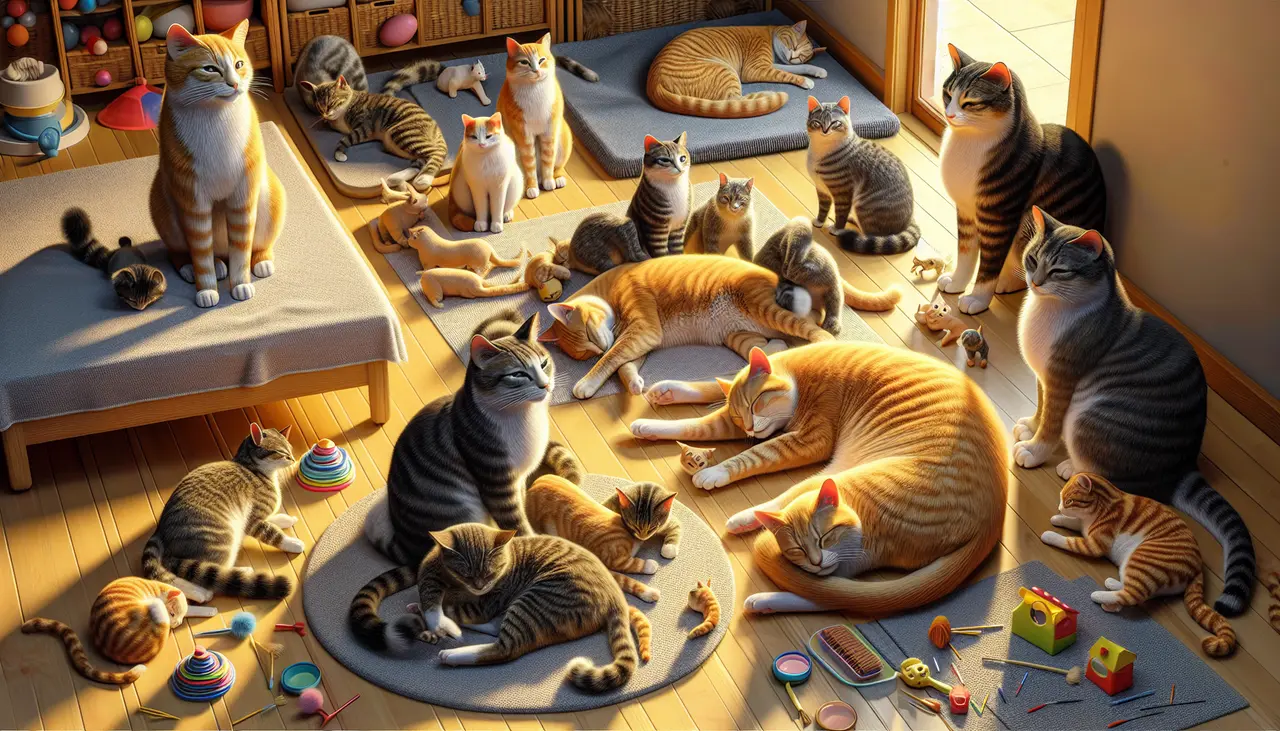Introduction to Cat Socialization
Cats, like humans, have their own unique personalities. Some are born social butterflies, eager to meet new furry friends, while others may be more reserved, preferring the company of their human family. Cat socialization refers to the process of gently introducing your cat to new experiences, animals, and people, helping them become more comfortable and confident in various situations. It’s not just about making friends; it’s about building trust and teaching your cat that the world is not a scary place. This process can start from as early as a few weeks old and continue throughout their lives. Remember, patience and gradual exposure are key. No two cats socialize the same way, so it’s important to tailor the approach to your cat’s individual personality and comfort level.
The Importance of Socializing Your Cat
Getting your cat to socialize matters more than you might think. It’s not just about having fun. Socialized cats are generally happier, healthier, and more well-behaved. From a young age, cats learn to trust humans and get along with other pets through socialization. This doesn’t just make your life easier; it sets them up for a stress-free life. Think about it like this: social skills for cats are as crucial as they are for us humans. A cat that’s good at socializing won’t be the one hiding under the bed when guests come over. Instead, they’ll be part of the welcoming committee. Starting early is key. Young kittens are much like sponges, eager and ready to soak up new experiences. This window of opportunity is your golden ticket to molding a friendly, adaptable cat. But don’t worry if your cat is older; they can still learn the tricks of the social trade, though it might take a bit more patience and creativity. Remember, every cat has its unique personality. Socializing helps them express it confidently and calmly, whether they’re the life of the party or prefer just a few close friends.
Recognizing Signs of Social Anxiety in Cats
Cats, just like us, can feel nervous or uneasy in new situations or around new furry friends. Spotting social anxiety in your cat is key to helping them overcome it. Look out for signs like hiding more than usual, avoiding both humans and other animals, hissing or swatting when approached, and changes in eating or bathroom habits. A cat sitting with its ears flat against its head or tail tucked might also be feeling anxious. Understanding these signs is the first step in helping your cat feel more comfortable and sociable. Remember, patience and gentle encouragement go a long way in supporting your cat through social anxiety.
Basic Steps in Cat Socialization
To socialize a cat, start early and keep it simple. First, introduce your cat to new people, pets, and environments gradually. Don’t rush; let your cat take its own time to explore and get comfortable. It’s like dipping your toes in the water before taking a full dive. Second, use treats and toys. Think of these as ice breakers at a party, helping your cat to associate new experiences with positive feelings. Third, maintain a routine. Cats love predictability. Regular playtimes and feeding schedules create a sense of security, making it easier for your cat to deal with new situations. Lastly, be patient and keep interactions positive. If your cat seems stressed, take a step back and try again later. Remember, socialization is a marathon, not a sprint.
Tips for Introducing Your Cat to Another Cat
Introducing your cat to another cat can feel like a big step. Here’s how to make this process smoother. Start by keeping them separate at first. Put the new cat in a different room so they can get used to each other’s scents without meeting face-to-face. Swap their bedding after a day or so. This helps them become familiar with the other’s scent. Next, feed them on opposite sides of a closed door. They start associating the other’s presence with something positive like food.
Use a baby gate or a cracked door for the first visual introduction. This way, they can see each other without direct contact. But, keep these visits short to avoid stress. If both cats seem curious and calm, allow supervised, direct interactions. Expect some hissing or paw swats; it’s normal as they’re setting boundaries. Always have a plan to separate them quickly if things get out of hand.
Remember, patience is key. Some cats warm up to each other quickly, while others need more time. Don’t rush them, and celebrate small victories like calm coexistence or shared spaces. Every cat has its pace. With time and patience, your cats might just turn into best friends.
How to Introduce Your Cat to Dogs
Introducing your cat to a dog needs patience. Start by keeping them in separate rooms. Exchange their bedding after a couple of days so they can get used to each other’s scent. It’s crucial to have your dog on a leash during their first face-to-face. Short, controlled meetings are best. Always reward calm behavior with treats. Remember, the goal is a peaceful coexistence, not best friends overnight. Don’t rush it. Every cat and dog pair is different; some might take days, others weeks or even months to get along. Keep an eye out for signs of stress in both pets and back off if needed. Slow and steady wins this race.
Creating a Safe Environment for Cat Socialization
To help your cat make friends, it’s crucial to create a safe space first. This means your home should be a stress-free zone where your cat feels secure. Start with a quiet room where your new cat or kitten can get used to the sounds and smells. Use items like their bed, toys, and even their litter box to help them feel at home. Remember, your cat’s pace is key; let them explore this space on their terms. As your cat starts feeling comfortable, gradually introduce them to other parts of the house. If you have other pets, it’s essential to manage these introductions carefully. Ensure each pet has its safe spot to retreat if they feel threatened. Always supervise their first interactions until you’re sure they get along well. Creating such a space doesn’t just mean physical safety but also the assurance that they can retreat when overwhelmed. This approach will help your cat build confidence over time, making socialization with other cats and even humans much smoother.
The Role of Play in Cat Socialization
Play isn’t just fun for cats; it’s a crucial part of their socialization, especially when they’re young. Through play, cats learn vital social skills such as interpreting signals from other cats, establishing social hierarchies, and understanding boundaries. It mimics the predatory behaviors necessary for survival in the wild – stalking, chasing, pouncing, and biting. This isn’t just about physical exercise; it’s about mental growth too. When cats play with each other, they’re practicing communication skills. For example, they signal when they’ve had enough or when a bite is too hard. This is how they learn to coexist peacefully. If you’re introducing a new cat into your home, supervised playtime can help them get to know their future feline companions in a safe and controlled environment. Remember, all cats are different; some may take longer to warm up to playtime than others. Be patient and observe their comfort levels, adjusting playtime accordingly.
Handling Setbacks in Cat Socialization Efforts
Sometimes, despite your best efforts, cat socialization doesn’t go as planned. It’s normal, and it happens. Setbacks can be anything from your cat hiding more than usual to reacting aggressively toward a new feline friend. If this happens, take a step back. It’s key to go at your cat’s pace. Rushing or forcing interactions can make things worse. First, give your cat some space. Let them have a safe spot where they feel secure. Next, slowly reintroduce the basics of socialization. You might need to start from square one, but that’s okay. It’s also useful to watch for signs of stress or discomfort in your cat. These can be subtle, like overgrooming or changes in eating habits. Recognizing these signs early can help you adjust your approach. Remember, every cat is different. Patience is your best ally here. And if you’re really stuck, consulting with a vet or a cat behaviorist can give you tailored advice for your furry friend’s unique personality and needs.
Conclusion: The Lifelong Benefits of Cat Socialization
When it comes down to it, encouraging your cat to socialize isn’t just about having a friendly feline. It’s about giving them a better, healthier life. Cats that learn to interact well with others often lead more content, stress-free lives. They’re less likely to develop behavior problems, which means fewer scratched sofas and fewer midnight zoomies. Plus, social cats can adapt more easily to new situations, whether it’s moving to a new home, welcoming a new pet, or visiting the vet. Ultimately, taking the time to socialize your cat pays off in a happier cat and a happier you. Consider it time well invested in your furry friend’s well-being.

















